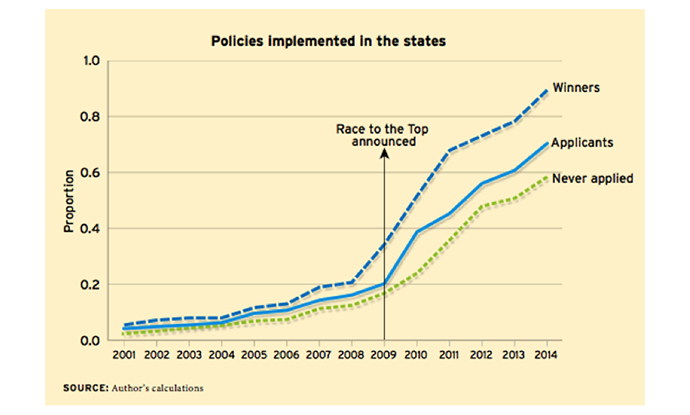Contact:
William Howell: whowell@uchicago.edu, (312) 550-3767
Amanda Olberg: amanda_olberg@hks.harvard.edu, (617) 496-2064, Education Next Communications Office
Race to the Top Competition Changes State Education Policies
Winners enact new initiatives, strengthen standards and expand charters
With Race to the Top (RttT), the Obama administration sought to stimulate education reform among the states. Five years have passed since the final winners in the $4 billion contest were announced, so there has been enough time to assess whether the program encouraged meaningful education reform or promised a lot but changed little. Now University of Chicago presidential scholar, William Howell, analyzes the effects of RttT in a new research article for Education Next.
Howell’s overall findings indicate that RttT has had a substantial impact on education policy across the United States, confirming observations by many participating states. Says Howell, “The evidence suggests that by strategically deploying funds to cash-strapped states and massively increasing the public profile of a controversial set of education policies, the president managed to stimulate reforms that had stalled in state legislatures.” Consistent with Howell’s findings, Illinois state senator Kimberly Lightford noted, “I think Race to the Top was our driving force to get us all honest and fair, and willing to negotiate at the table.”
Specifically, RttT was designed to encourage higher state standards, create new data systems, improve teacher effectiveness, increase college readiness, stimulate charter-school expansion, and strengthen low-performing schools. In applications for federal funding, states were asked to describe their current policies and outline their goals to meet the initiative’s criteria. Across the three phases of RttT, 18 states and the District of Columbia won awards that ranged from $17 million to $700 million.
In order to see if RttT stimulated the adoptions of education reforms, Howell examined whether a statewide governing body had actually enacted (not just proposed) upwards of 33 qualifying policies each year between 2001 and 2014. He found that states enacted reform policies at a much higher rate in the aftermath of RttT than previously.
Between 2001 and 2008, the year before RttT was authorized, states, on average, enacted about 10 percent of proposed reform policies. Between 2009 and 2014, however, they enacted 68 percent. Between 2001 and 2008, states that won an award, those that applied but did not win, and those that never applied were nearly indistinguishable from one another. But by 2014, winning states had adopted 88 percent of the recommended reform policies on average, states that applied but had not won had adopted 68 percent, and even states that never applied had adopted 56 percent of the recommended reform policies. Howell and his team conclude that the process of applying to the competitions by itself, plus the increased media attention given to RttT policies, generated momentum behind policy reform. See the figure below.
Howell also found that winning states were more likely to raise their proficiency standards after RttT was authorized, suggesting that RttT’s influence carried over into the implementation stage of education policymaking. RttT did not accelerate previous trends in charter school enrollments. The growth in charter school enrollments in winning states, however, continued to climb at a higher rate than charter growth rates in other states.
The article features an interactive map showing the percentage of Race to the Top policies implemented from 2001 through 2014, state by state. See the map at: https://www.educationnext.org/race-top-policy-map-2015/.
Two other scholars debate the success of RTT in a forum for Education Next. Joanne Weiss, former chief of staff to U.S. Secretary of Education Arne Duncan, says that the initiative spurred comprehensive improvements nationwide, especially in standards and assessments, teacher evaluation methods, and public school choice. Frederick M. Hess from the American Enterprise Institute argues that any reforms will be short lived or ineffective, since they are shaped by a top-down effort to spur innovation.
“Results of President Obama’s Race to the Top: Win or lose, states enacted education reforms” by William G. Howell is available now on https://www.educationnext.org and will appear in the Fall 2015 issue of Education Next, available in late August.
“What Did Race to the Top Accomplish?” a forum with Joanne Weiss and Frederick Hess, is available now on https://www.educationnext.org and will appear in the Fall 2015 issue of Education Next, available in late August.
About the Authors
William Howell is the Sydney Stein professor in American Politics at the University of Chicago, and the author of numerous books on the presidency.
Joanne Weiss is the former chief of staff to U.S. Secretary of Education Arne Duncan and director of the federal Race to the Top program.
Frederick M. Hess is director of education policy studies at the American Enterprise Institute. His books include Carrots, Sticks, and the Bully Pulpit: Lessons from a Half-Century of Federal Efforts to Improve America’s Schools.
About Education Next
Education Next is a scholarly journal published by the Hoover Institution that is committed to careful examination of evidence relating to school reform. Other sponsoring institutions are the Program on Education Policy and Governance at Harvard University, part of the Taubman Center for State and Local Government at the Harvard Kennedy School, and the Thomas B. Fordham Foundation. For more information about Education Next, please visit: https://www.educationnext.org.



